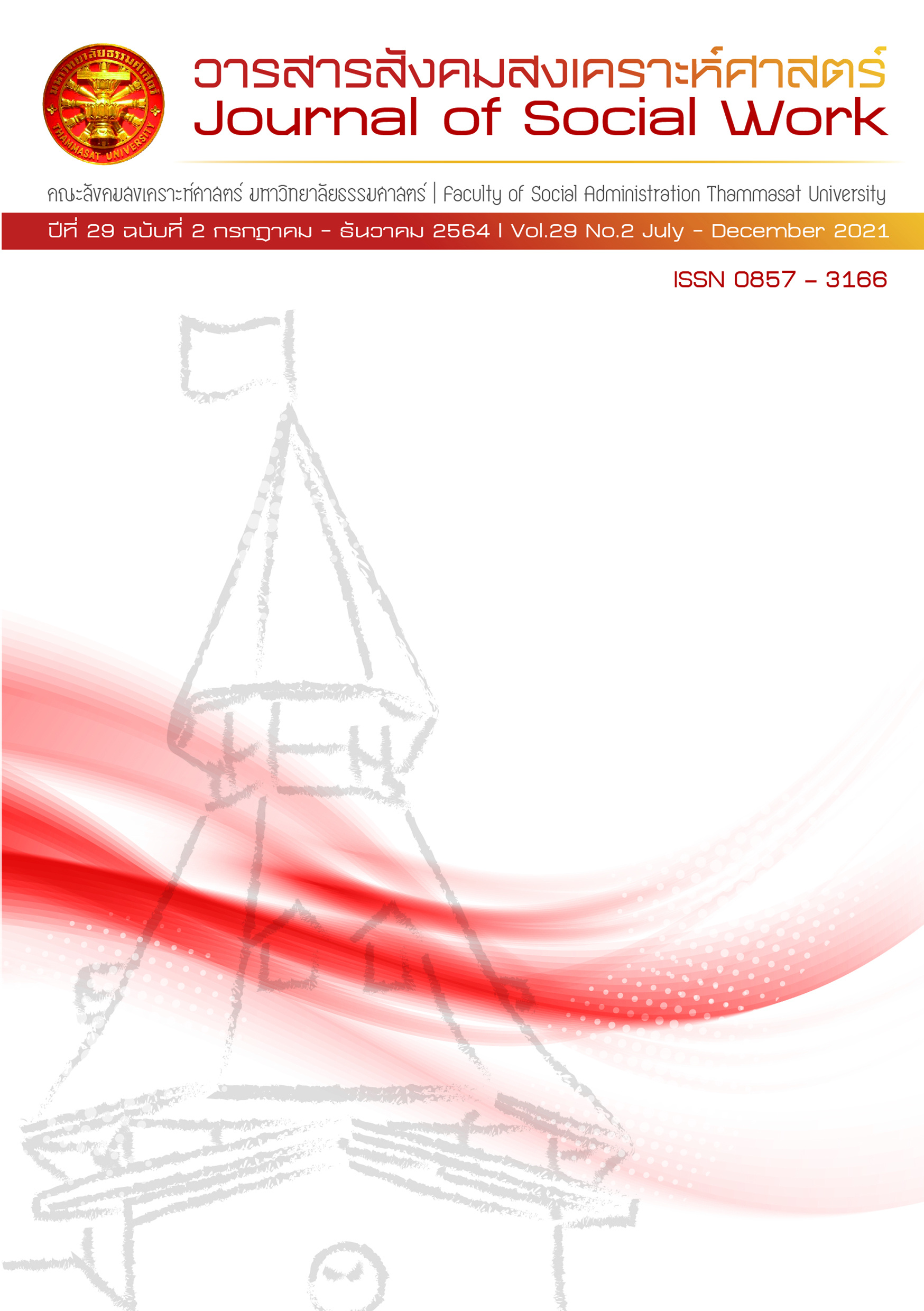Returning Home: Preparation process for Children and Woman Violence from Emergency Housing
Keywords:
Preparation for returning to family, Abused children and women, Shelter residenceAbstract
This research has as its objective the study of forms, processes and results of the preparation for children and women to return to their families. This qualitative research employed an in-depth interview using tools of a semi-structured interview, participant observation, and non-participant observation. The participants were divided into three groups: Group 1, including three multi-disciplinary staff working at a shelter residence; Group 2, including four social workers; and Group 3, including two service users who have already returned to their family.
The results of the study revealed that the preparation for children and women to return to their family (1) mainly used a specific social case work method, especially in form of case management, while a social group work methodology was additionally applied. In this regard, case management focused on enhancing the quality of effective correction, treatment, and rehabilitation in order that the service users could receive the greatest benefit, and the services best met users’ needs; (2) consisted of all steps of social work practices. In addition, practitioners needed to be familiar with techniques and possess work skills including interviews, home visits, counseling, family-based social work practices, as well as monitoring and evaluation. It also showed that (3) service users who returned to their families were highly satisfied with the preparation. This was because the preparation process conducted by the shelter residence offered a variety of activities and covered their needs. The result of the preparation helped create sustainability for the service users as they could remain out of trouble, have stability in life, and never return to the cycle of violence. This reflects that the social work process has brought the service users back to be able to live their lives with dignity.
References
กรมสุขภาพจิต. (2563). อึ้ง ! ผู้หญิงถูกกระทำความรุนแรงครึ่งปี 2563 พุ่งกระฉูด 12%. สืบค้นจาก https://www.dmh.go.th/sty_lib/news/news/view.asp?id=30401
นักจิตวิทยา. นักจิตวิทยา สมาคมส่งเสริมสถานภาพสตรีฯ บ้านพักฉุกเฉิน. (4 กุมภาพันธ์ 2564). สัมภาษณ์.
นักสังคมสงเคราะห์คนที่ 1. นักสังคมสงเคราะห์ สมาคมส่งเสริมสถานภาพสตรีฯ บ้านพักฉุกเฉิน. (28 มกราคม 2564). สัมภาษณ์.
นักสังคมสงเคราะห์คนที่ 2. นักสังคมสงเคราะห์ สมาคมส่งเสริมสถานภาพสตรีฯ บ้านพักฉุกเฉิน. (4 กุมภาพันธ์ 2564). สัมภาษณ์.
ผู้ช่วยนักสังคมสงเคราะห์คนที่ 1. ผู้ช่วยนักสังคมสงเคราะห์ สมาคมส่งเสริมสถานภาพสตรีฯ บ้านพักฉุกเฉิน. (18 กุมภาพันธ์ 2564). สัมภาษณ์.
ผู้ช่วยนักสังคมสงเคราะห์คนที่ 2. ผู้ช่วยนักสังคมสงเคราะห์ สมาคมส่งเสริมสถานภาพสตรีฯ บ้านพักฉุกเฉิน. (18 กุมภาพันธ์ 2564). สัมภาษณ์.
วราภรณ์ เหลืองวิไล และ ศิรินทร์รัตน์ กาญจนกุญชร. (2563). เหตุแห่งการกระทำรุนแรงในครอบครัวต่อสตรีตามบริบทของสังคมไทย.
งานประชุมวิชาการระดับชาติ ครั้งที่ 12. มหาวิทยาลัยราชภัฏนครปฐม, จังหวัดนครปฐม ประเทศไทย, 9-10 กรกฎาคม 2563.
สมาคมส่งเสริมสถานภาพสตรีในพระอุปถัมภ์พระเจ้าวรวงศ์เธอ พระองค์เจ้าโสมสวลี กรมหมื่นสุทธนารีนาถ. (2554). งานด้านสังคมสงเคราะห์ กลุ่มเป้าหมาย ผู้หญิงและเด็กที่ประสบปัญหาเดือดร้อนเฉพาะหน้า. สืบค้นจาก http://www.apsw-thailand.org/socialworker-th.html
สมาคมส่งเสริมสถานภาพสตรีในพระอุปถัมภ์พระเจ้าวรวงศ์เธอ พระองค์เจ้าโสมสวลี กรมหมื่นสุทธนารีนาถ. (2562). สรุปรายงานผลดําเนินงานปี 2562. กรุงเทพ: สมาคมส่งเสริมสถานภาพสตรีในพระอุปถัมภ์พระเจ้าวรวงศ์เธอ พระองค์เจ้าโสมสวลี กรมหมื่นสุทธนารีนาถ.
สิทธิศักดิ์ วนะชกิจ. (2552). การคุ้มครองผู้ถูกกระทำด้วยความรุนแรงในครอบครัว. จุลนิติ, 6(6), 52-53.
สุรางค์รัตน์ วศินารมณ์. (2554). การจัดการรายกรณีในงานสังคมสงเคราะห์(พิมพ์ครั้งที่ 1). กรุงเทพฯ: สำนักพิมพ์มหาวิทยาลัยธรรมศาสตร์.
สุรางค์รัตน์ วศินารมณ์. (2554). ทักษะการปฏิบัติงานสังคมสงเคราะห์ (พิมพ์ครั้งที่ 4). กรุงเทพฯ: สำนักพิมพ์มหาวิทยาลัยธรรมศาสตร์.
หัวหน้าศูนย์เลี้ยงเด็กอ่อนและรักษาการหัวหน้าบ้านเด็ก. หัวหน้าศูนย์เลี้ยงเด็กอ่อนและรักษาการหัวหน้าบ้านเด็ก สมาคมส่งเสริมสถานภาพสตรีฯ บ้านพักฉุกเฉิน. (11 กุมภาพันธ์ 2564). สัมภาษณ์.
Coulshed, V., & Orme, J. (1998). Social work practice: An introduction. Macmillan International Higher Education.
Downing, J., & Thackray, D. (1971). Reading Readiness. A UKRA (United Kingdom Reading Assn.) Teaching of Reading Monograph.
Eyal-Lubling, R., & Krumer-Nevo, M. (2016). Feminist social work: Practice and theory of practice. Social Work, 61(3), 245-254.
Guitierrez, L. M., & Ortega, R. (1991). Developing methods to empower Latinos: The importance of groups. Social work with groups, 14(2), 23-43.
Hughes, J. (2020). Women’s advocates and shelter residents: Describing experiences of working and living in domestic violence shelters. Journal of interpersonal violence, 35(15-16), 3034-3053.
Naumburg, M. (1966). Dynamically oriented art therapy: Its principles and practices, illustrated with three case studies. Grune & Stratton.
Turner, S. G., & Maschi, T. M. (2015). Feminist and empowerment theory and social work practice. Journal of Social Work Practice, 29(2), 151-162.
Downloads
Published
How to Cite
Issue
Section
License
Copyright (c) 2021 Journal of Social Work

This work is licensed under a Creative Commons Attribution-NonCommercial-NoDerivatives 4.0 International License.
The manuscripts published in the Social Work Journal is the copyright of the Social Work Journal, Thammasat University
Any article or opinion appeared in the Social Work Journal will solely be under the responsibility of the author The Faculty of Social Administration, Thammasat University and the editors do not need to reach in agreement or hold any responsibility.



